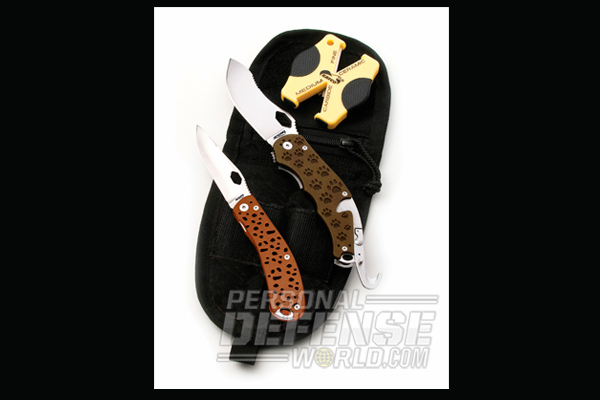D2 TOOL STEEL:
D2 tool steel first emerged during the World War II era. As this nation’s wartime efforts moved from individual craftsmen working with their hands to mechanization, the inherent toughness and excellent wear resistance found in D2 allowed it to be widely used in stamping dies. The basic formulation of this steel is as follows—carbon 1.40-1.60 percent; chromium 11-12 percent; nickel 0.30 percent; magnesium 0.40-0.60 percent; molybdenum 0.7-1.20 percent; silicone 0.3 percent and vanadium 0.8-1.10 percent. Rockwell hardness range (depending on the manufacturer) is RC 57-62, with blades typically hardened to the upper range. Since D2 is tool steel, it’s susceptible to staining and corrosion. However, when compared with other tool steels, the elevated chromium content (11-12 percent) of the formulation has garnered D2 a reputation for superior corrosion and stain resistance. My own experience in the field with this steel has shown that the effects of environmental attacks (blood, body fluids and ambient moisture) on this steel are restrained if reasonable care is used.
“With minimal care, D2 can remain free from corrosion and staining for the lifetime of the blade.”
“With minimal care, D2 can remain free from corrosion and staining for the lifetime of the blade.”
D2 does have some other drawbacks as blade steel. It can be difficult to polish properly, with many manufacturers opting to avoid attempts at mirror polishing simply because it takes too much time and effort with little to gain. Furthermore, since D2 blades are typically Rockwell hardened to RC 60-61, some users will encounter difficulties with edge reestablishment. At the same time, once a D2 blade has been sharpened properly, it will hold its edge much longer than blades with a lower Rockwell hardness. That is just one of the normal trade-offs between steel alloys.
Advertisement — Continue Reading Below
CPM-D2:
Some time ago, the folks at Crucible produced a small run of CPM-D2 using their proprietary “Particle Metallurgy” process. The purpose of using this process was to make a blade steel that had fine grain structure, improved finish, enhanced toughness and was easier to machine and grind. Since this process produces molecular elements that are more consistent in size, the result was a more homogeneous distribution of the various chemical components within CPM-D2. Potentially, this could lead to a finer and more consistent cutting edge as well as better edge retention. However, when you compare a regular D2 blade with the finer edge found on a CPM-D2 blade, it has been found that the somewhat “toothy” cutting edge (from the larger presence of chromium and vanadium carbide) of the D2 blade offers extended functional performance. In the end, which version works best for you may depend on what you intend to cut. A toothy edge is useful for hide and flesh, but a smooth, polished cutting surface has advantages for woodworking and cutting fish.
When it comes to toughness, CPM-D2 has the potential of being a little more ductile than regular D2. Since the actual in-the-field performance differences (functional edge retention and sharpening ease) between regular D2 and CPM-D2 have not proven to be significant, coupled with the increased cost of CPM-D2, regular D2 has remained the blade steel of choice by manufacturers and custom makers alike. While D2 blade steel will rust and stain quicker than any of the stainless blade steels, its elevated chromium content does offer enough resistance to environmental attacks to garner it the title of “semi-stainless.” With minimal care, D2 can remain free from corrosion and staining for the lifetime of the blade. Furthermore, the vanadium content of D2 provides enhanced edge retention, which makes it historically superior blade steel. For these reasons you’ll find D2 blade steel used in the knife inventories of Queen Cutlery, Dozier Knives, Timberline and many other manufacturers and custom makers. D2 is a fine example of the old saying: “If it’s not broke, don’t fix it.”
Advertisement — Continue Reading Below
Should you have the occasion to browse through any retail location that sells hunting gear, you’ll most likely encounter ammunition-reloading supplies. Among the boxes of new brass cartridge cases, primers, bullets and related paraphernalia there will be an assortment of various propellants. Even though some of these powders have been recently developed, many of the more popular ones have a long history of use going back for decades. Likewise, despite the more recent development of several stainless formulations, some of the blade steels in use today also have rather historical lineages.
For more information, visit:
timberlineknives.com or call 800-548-7427
Advertisement — Continue Reading Below
queencutlery.com or call 814-827-3673
dozierknives.com or call 888-823-0023
























